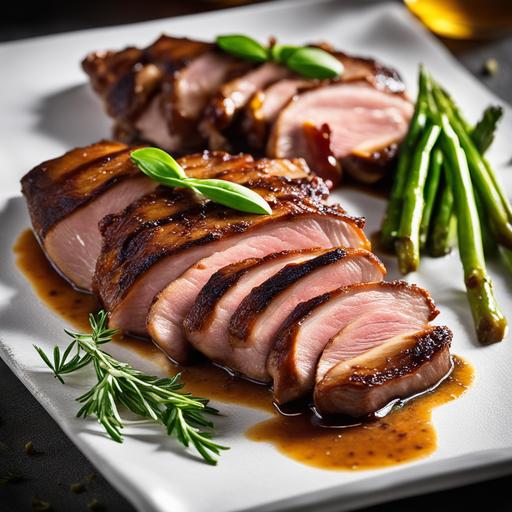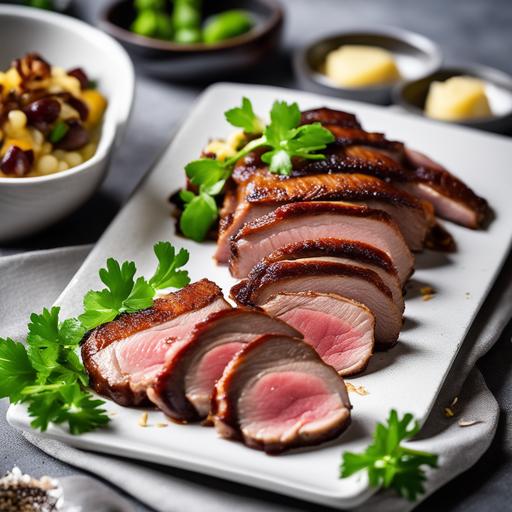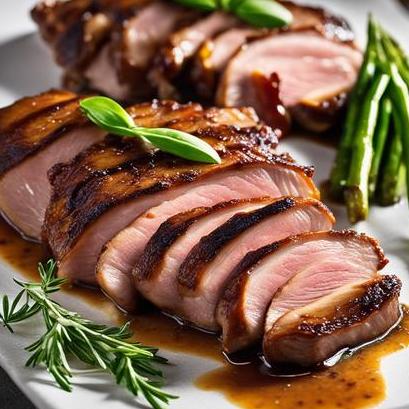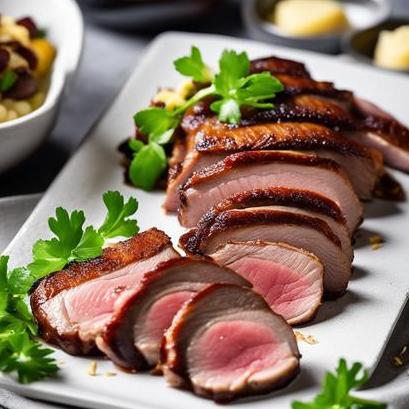
The Pleasures Of Duck Breast Fillets: An In-Depth Oven Recipe Guide
Duck breast fillets, when prepared with love and attention, can result in a truly decadent and exquisite dish that will leave your taste buds yearning for more. From the tender texture to the rich flavor, cooking duck breast fillets in the oven opens up endless creative possibilities. In this comprehensive guide, we will delve into the intriguing world of duck breast fillets, exploring their food science, culinary details, selection, cleaning, preparation, tips, variations, doneness checks, and even discuss the calamities that may arise from overcooking or undercooking this delicacy. So, put on your chef’s hat and let’s dive in!
Understanding the Food Science
Before we embark on our culinary adventure, it’s essential to grasp the food science behind duck breast fillets. Understanding these elements will help you make informed decisions during the cooking process and yield fantastic results.
Duck breast fillets consist of lean meat surrounded by a layer of delicious, melt-in-your-mouth fat. This fat not only provides moisture and flavor to the meat but also protects it during the cooking process, preventing it from becoming dry and tough. The high fat content in duck breast fillets also contributes to their rich taste.
Culinary Details: Selecting the Perfect Duck Breast Fillets
Choosing the right duck breast fillets is crucial to ensure a successful culinary endeavor. Look for fresh, plump, and firm fillets that have a deep ruby red color. Avoid any fillets with a grayish hue or a strong odor, as these indicate deterioration.
While there are various duck breeds available, Muscovy or Moulard duck breast fillets are highly sought after for their exceptional flavor and tenderness. Opting for organic or free-range duck will also enhance the overall taste of your dish.
Cleaning and Preparing the Fillets

Once you’ve obtained the perfect duck breast fillets, it’s time to clean and prepare them for the oven. Begin by patting the fillets dry with a paper towel. This step removes excess moisture and helps achieve a crispier skin during cooking.
Next, inspect the fillets for any remaining feathers or bone fragments. Use a pair of tweezers to pluck out any feathers and a small knife to trim away any unwanted bits. Take care not to remove too much fat from the fillets during this process, as it plays a crucial role in flavor and moisture retention.
Tips and Tricks for Success

To ensure your duck breast fillets turn out perfectly cooked and bursting with flavor, follow these tips:
-
Score the skin: Before placing the fillets in the oven, use a sharp knife to score the skin in a diamond pattern. This aids in rendering out some of the fat, resulting in a crispier skin.
-
Seasoning: Season the fillets generously with salt and pepper, allowing the flavors to penetrate the meat. You can also experiment with additional herbs and spices to complement the richness of the duck.
-
Resting Period: After cooking the fillets, allow them to rest for a few minutes before slicing. This helps redistribute the juices, resulting in a tender and juicy texture.
-
Save the rendered fat: As the duck breast fillets cook, they release a delicious fat. Reserve this fat and use it for adding flavor to other dishes, such as roasted vegetables or even sautéing potatoes.
Variations: Exploring Endless Flavor Combinations

Once you’ve mastered the basic oven recipe for duck breast fillets, don’t be afraid to experiment with a range of flavors and ingredients. Here are a few variations to inspire your culinary creativity:
-
Orange Glaze: Combine freshly squeezed orange juice, honey, and a touch of ginger for a sweet and tangy glaze. Brush it over the fillets during cooking for an irresistible flavor combination.
-
Red Wine Reduction: Simmer red wine, shallots, and a splash of balsamic vinegar until thickened. Drizzle this luscious reduction over the sliced duck breast fillets for a sophisticated twist.
-
Asian Fusion: Marinate the duck breast fillets in a mixture of soy sauce, sesame oil, garlic, and ginger. Grill or roast the fillets until perfectly cooked, then serve with steamed bok choy and a side of fluffy jasmine rice.
With a diverse array of flavors at your disposal, the possibilities are endless for transforming your duck breast fillets into a culinary masterpiece.
Checking for Doneness: Achieving Perfection

Determining the ideal doneness for duck breast fillets can sometimes be intimidating, but fear not! Use these methods to ensure your fillets are cooked to perfection:
-
Internal temperature: Invest in a good instant-read meat thermometer and aim for an internal temperature of 130°F to 135°F (55°C to 57°C) for medium-rare, 140°F to 145°F (60°C to 63°C) for medium, or adjust according to your personal preference.
-
Finger test: If you’re a seasoned chef, you can also employ the finger test. Gently press the fillets with your finger – they should feel slightly springy for medium-rare and firmer for medium. However, the thermometer method is always more accurate.
Overcooking and Undercooking: Navigating the Perils
As with any culinary endeavor, the possibility of overcooking or undercooking your duck breast fillets exists. Let’s explore the consequences and ways to salvage your dish if you find yourself in either predicament.
Overcooked Duck Breast Fillets: Overcooking can result in dry, tough meat, robbing you of the tender texture you desire. However, all hope is not lost! You can attempt to rescue an overcooked duck breast by slicing it into thin strips and tossing it in a flavorful sauce or stir-fry. This will help rehydrate and tenderize the meat while masking any dryness.
Undercooked Duck Breast Fillets: Undercooking your fillets can be equally disappointing, leading to an unpleasant chewy texture. If this happens, slice the fillets into thinner pieces and quickly sear them in a hot pan to achieve the desired doneness. This method also adds a lovely caramelized crust to the exterior.
Oven Recipe for Duck Breast Fillets: A Step-by-Step Guide
Now that we’ve explored the various aspects surrounding duck breast fillets, it’s time to present you with a foolproof oven recipe to guide your culinary adventure. Brace yourself for a heavenly dish that will tantalize your taste buds!
Ingredients:
-
2 duck breast fillets
-
Salt and pepper (to taste)
-
Additional herbs and spices (optional)
-
Sauce or glaze of your choice (optional)
Instructions:
-
Preheat your oven to 400°F (200°C).
-
Pat dry the duck breast fillets using a paper towel.
-
Score the skin of the fillets in a diamond pattern, being careful not to cut into the meat.
-
Season the fillets generously with salt, pepper, and any additional herbs or spices you desire.
-
Heat an oven-safe skillet over medium-high heat.
-
Place the duck breast fillets skin-side down in the skillet, allowing the fat to render and the skin to become crispy. Cook for approximately 4-6 minutes or until golden brown.
-
Flip the fillets and sear the other side for an additional 2 minutes.
-
Transfer the skillet to the preheated oven and roast the fillets for approximately 8-10 minutes for medium-rare or adjust the cooking time according to your desired level of doneness.
-
Remove the fillets from the oven and let them rest on a cutting board for 5 minutes.
-
Slice the duck breast fillets diagonally and serve with your favorite sauce or glaze.
Conclusion
Congratulations! You’ve embarked on an epic journey through the world of duck breast fillets and embraced the art of cooking them to perfection in the oven. Armed with a deep understanding of the food science, culinary details, tips, tricks, variations, and even ways to salvage any mishaps, you are now equipped to create an extraordinary dining experience.
With each succulent bite of tender, flavorful duck breast fillets, you’ll be reminded of the culinary wonders you’ve discovered. So, gather your ingredients, fire up your oven, and let the symphony of flavors dance on your palate. Bon appétit!
FAQS On Duck Breast Fillets Oven Recipe
What Is The Best Way To Prepare Duck Breast Fillets In The Oven?
The best way to prepare duck breast fillets in the oven is to score the skin, season them with salt and pepper, and place them skin-side down in a cold, oven-safe skillet. Cook them over low-to-medium heat for a few minutes until the fat has rendered out and the skin is crispy. Flip the fillets over and transfer the skillet to a preheated oven to finish cooking for about 6-8 minutes until cooked to your desired doneness.
Should I Marinate Duck Breast Fillets Before Cooking Them In The Oven?
Marinating duck breast fillets before cooking them in the oven is optional. However, it is recommended to season the fillets properly before cooking to enhance their natural flavor. You can also add some herbs and spices to the seasoning to give them an extra boost of flavor.
How Long Should I Cook Duck Breast Fillets In The Oven?
The cooking time for duck breast fillets in the oven varies depending on the size of the fillets and your desired doneness. Generally, it takes about 6-8 minutes in the oven after searing them on the stove-top. For best results, use a meat thermometer and cook the fillets to an internal temperature of 135-140°F for medium-rare and 150-155°F for medium.
What Should I Serve With Duck Breast Fillets Cooked In The Oven?
Duck breast fillets cooked in the oven go well with a variety of side dishes such as roasted vegetables, salad, wild rice pilaf, mashed potatoes, or a simple fruit and cheese plate. The pan juices from the duck can also be used to make a delicious sauce and drizzled over the fillets and side dishes.
Should I Let Duck Breast Fillets Rest Before Serving?
Yes, it is recommended to let duck breast fillets rest for a few minutes before slicing and serving. This allows the juices to redistribute throughout the meat, resulting in a more tender and flavorful dish. Cover the fillets with foil and let them rest for about 5-10 minutes before slicing and serving.



